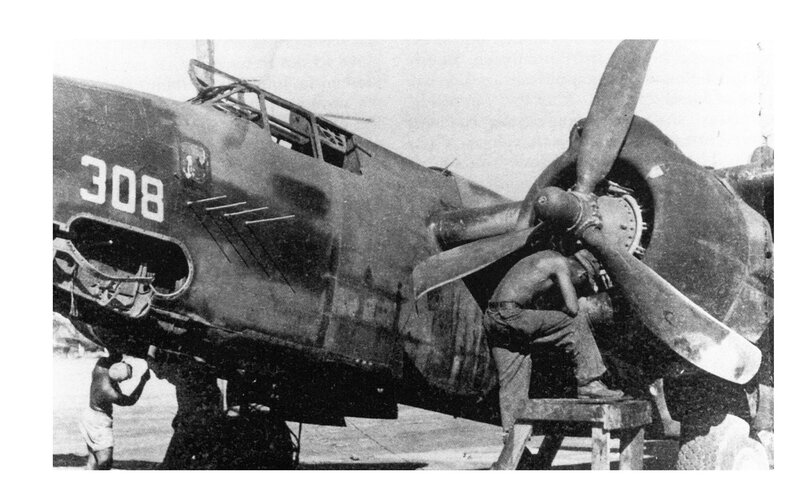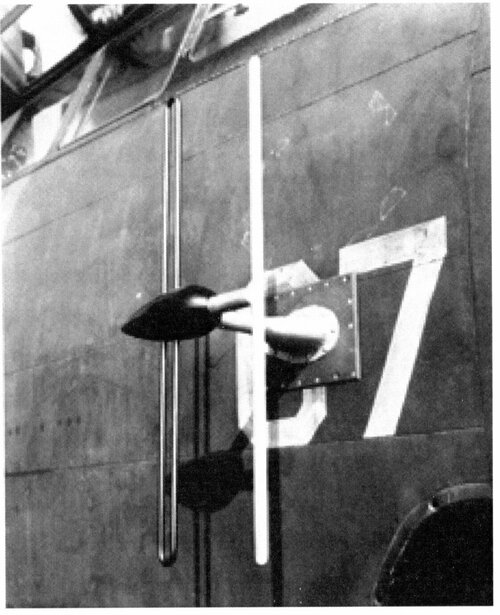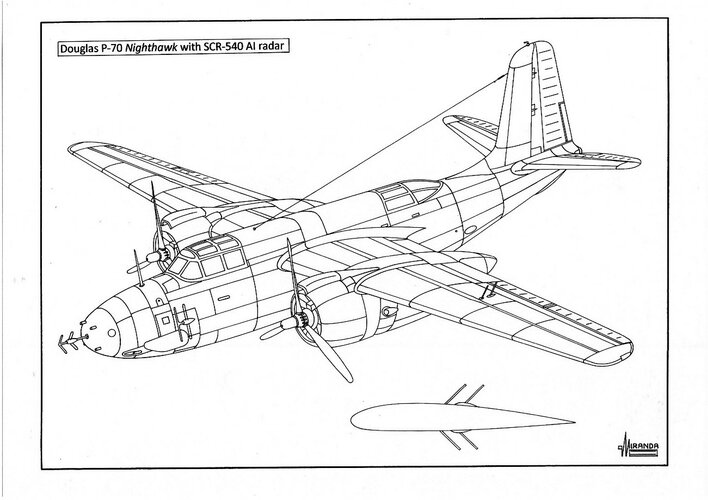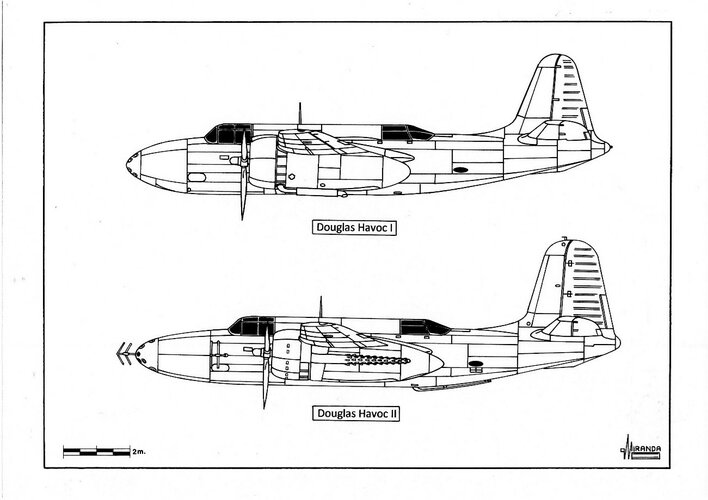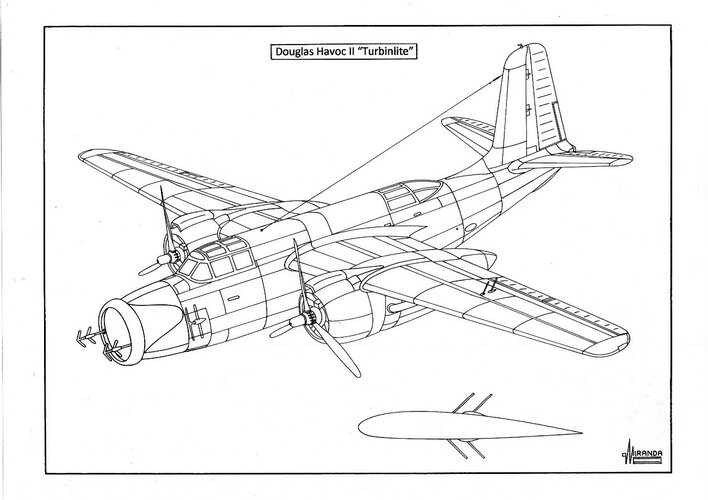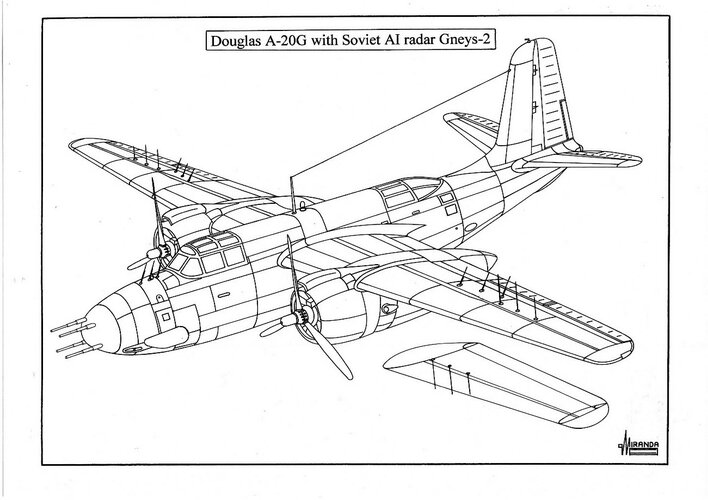In this Douglas P-70 night fighter of the 419th NFS, crash landed at Piva-Bougainville by Lt Donald Dessert, the fixed quarter wave dipoles for azimuth receiving have been replaced by four german style “Stachel” rods. Can anyone identify which radar they belong to?
You are using an out of date browser. It may not display this or other websites correctly.
You should upgrade or use an alternative browser.
You should upgrade or use an alternative browser.
Identify please (German radar in US fighter?)
- Thread starter Justo Miranda
- Start date
- Joined
- 19 July 2016
- Messages
- 3,982
- Reaction score
- 3,030
Still seems to be a variant of the UK AI MK IV to me, or have I missed something?
archipeppe
ACCESS: Top Secret
- Joined
- 18 October 2007
- Messages
- 2,372
- Reaction score
- 2,761
The US built version of AI Mk.IV known as SCR 540. The 4 horizontal aerials in photo one were superseded by the fuselage array in the other photos.
T. A. Gardner
ACCESS: Top Secret
- Joined
- 18 February 2021
- Messages
- 1,021
- Reaction score
- 1,775
Receiver. The antennas are on each side of the nose such that it acts like a ground plane. The difference in signal strength to the two antennas tells the operator how much off to one side or the other the target is. When the signals are equal, the plane is flying directly at the target.Sender or receiver?
It could be an experimental installation to save drag?

In this drawing, the receiving antenna are on the wings rather than on the sides of the nose, but it works the same way.
In October 1941, the Douglas Aircraft Co. plant of Santa Monica started the modification of fifty-nine A-20 bombers, re designated as P-70 A-1 Nighthawk.
The first units were equipped with one air interception radar Western Electric AI-10 and later with one SCR-540 (Signal Corps Radio), the US version of the British AI Mk IV operating in 1.5-m wavelength with Yagi antennae.
The transmitting bent folded director dipole, with director, was mounted in the solid nose; two fixed quarter wave dipoles, for azimuth receiving, were installed to the fuselage sides, and four fixed quarter wave slanted rods, for elevation receiving, were mounted above and below the port wing.
The IFF system Philco SCR-535, was the US version of the British IFF Mark II.
Armament consisted of two nose-mounted 0.50-in M2 Browning heavy machine guns, mostly armed with tracers and four 20-mm cannon housed in a ventral fairing.
A 300 US gallon long-range fuel tank was installed in the bomb bay.
The A-20 bomber was to have two turbo-supercharged Wright R-2600-7 engines, but the turbochargers proved troublesome, suffering serious cooling difficulties, and Douglas was forced to use two un-supercharged R-2600-11fitted with exhaust flame dampers.
This modification did not diminish the effectiveness of the A-20 as a low level strafing and antiship bomber. Below 10,000 ft. the airplane could easily out-turn the P-47 Thunderbolt.
The first batch of P-70s was delivered between April and September 1942, but with no superchargers the fighter proved too slow in climbing to 22,000 feet (45 minutes) and performed poorly above 20,000 ft.
In 1943, a second batch of thirty-nine A-20 C bombers were converted as P-70 A-1 night fighters, fitted with SCR-540 AI radar equipment. This version mounts four M2 machine guns, with flash suppressors, in the solid attack nose, and two M2s in lateral recessed tunnels.
The third batch of sixty-five A-20G bombers were converted to P-70 A-2 night fighters equipped with the same radar and weapon systems but without rear turrets.
Series A-1 and A-2 could carry up to two thousand pounds of bombs on night bombers and night harassment missions.
P-70 B-1 and B-2 versions were trainer conversions based on A-20 G and A-20 J bomber airframes. One B-1 and one hundred and four B-2 trainers were delivered in 1944.
These aircraft were used to train P-61 radar operators in the use of the new ‘centimetric’ (microwave) radars SCR 520B, SCR 720A and SCR 729.
The 6th Night Fighter Squadron, equipped with 25 Nighthawks, painted overall Dull Black 44, reached Hawaii in September 1942.
During the first months of 1943, Japan suffered heavy air losses against the second generation of Allied fighters: Corsair, Hellcat, Thunderbolt, Lightning, and Spitfire Mk. V. With the Allies having total air superiority during daylight, Japanese bombers were forced to perform night attacks, under the cover of darkness, to prevent their annihilation.
In February 1943, the 6th NFS (Detachment “B”) with six P-70 A-1 and two Curtiss P-40 K night fighters, was based at Koli Airfield-Guadalcanal with the mission of intercepting the night raids of the IJN bombers based in Russell Islands and Munda-New Georgia.
On April 19, 1943, a P-70 managed to shoot down a Mitsubishi G4M1 Betty bomber, but the Japanese were monitoring the US radio transmissions and, from then on, their bombers never came in lower than 28,000 ft, too high for the P-70.
The Nighthawks were too slow and heavy to be effective as night fighter and, eventually, some unmodified Lockheed P-38G day fighters of the 418th, 421st and 419th squadrons were used for high-altitude interceptions, working with GCI and searchlights, while the P-70s were restricted to low level missions, below 25,000 ft.
In June the decision was made to replace the Nighthawks with Lockheed P-38 J and G Day fighters that were to be used in conjunction with searchlights to find their targets.
At the end of August, the Lightnings, vectored by ground control radar, had shot down four Japanese aircraft, flying over 30,000 ft. or higher. The P-38 G could climb to 20,000 ft. in about 10 minutes.
The P-70s were henceforth used in nightly harassment runs over Bougainville.
The 419th NFS, with three P-70 A-2 night fighters and eight P-38 H Day fighters, arrived at Guadalcanal in November 1943.
The color scheme of the A-2 series was Olive Drab on top and Dull Black 44 below.
The PT boats patrolling during the night, to avoid Japanese landings, used to be attacked by IJN seaplanes of the Nakajima E8N1 Type 95 Dave and Mitsubishi F1M2 Pete types that launched flares before carrying out their strafing attacks.
Encounters with some P-70s of the 6th and 419th NFS occurred at Buka Passage, Fergusson Passage and over the Kolombangara coast, but the agile Japanese biplanes easily avoided attacks by employing their superior maneuverability.
In March 1943, the 6th NFS (Detachment ‘A’), with five P-70 night fighters of the first series, was based at ‘3-Mile Strip’ and Jackson Airfield ‘7-Mile Drome’ near Port Moresby-New Guinea.
These aircraft were armed with two M2 machine guns and four 20-mm cannons. In an attempt to improve their performances, they were equipped with new propellers from the B-17F bombers, fuel pumps from the P-38 Lightning and stripped of armor and rear guns.
On May 15, 1943, a P-70 managed to shoot down a Mitsubishi Ki.21 Sally bomber, flying at 26,000 ft.
In February 1944, the 421st NFS arrived at Port Moresby with seven P-70 A-2 and one P-38H.
Some aircraft from 421st (Detachment ‘A’) were based in Saidor (north-eastern coast) to be used in weather reconnaissance, strafing, and night bombing missions.
The Detachment ‘B’ was based in Wakde Island and their aircraft were used in routine night patrols.
On June 5, 1944, a night raid performed by several Betty bombers managed to destroy 30 American aircraft in Wakde Island.
The US alarm system consisted of several obsolescent early warning ground-based radars SCR 270 (3-meter wavelength) and SCR 527 (1.5-meter) with inexperienced operators. The SCR 270 provided only the azimuth to the target but not its altitude.
The ground control vectored one patrolling P-70 to intercept the approaching bombers, but the pilot was forced to abandon the attack due to failures in both engines while flying at 5,500 ft.
By the end of June, the Nighthawk had been phased out of operations and was replaced by P-38 fighters and B-25 bombers until the arrival of the P-61 Black Widow in August.
In August 1944 the Soviet night fighters Petlyakov Pe-2 and Pe-3 were replaced by Lend-Lease Douglas A-20G-1 American planes, slower than the Pe-2 but with more powerful armament.
These aircraft were modified in Factory No. 81 with Gneys-2 radars, three nose mounted transmitting dipoles, three vertically polarized azimuth dipoles mounted above the top surface of each wing, and six elevation dipoles (with 45 degrees of inclination) installed on the starboard wing, three on the upper face and three on the lower, SCR-695 IFF transponders, and SCR-718 radio-altimeters.
The transmitting dipoles generated a cone-shaped detection blind zone with 7 degrees of amplitude in front of the plane, a defect that could not be corrected and that affected the radar effectiveness.
Between August 1944 and April 1945, the Douglas night fighters carried out 246 combat missions with air division Breslavlskaya, but only managed to shoot down two glider tug Heinkel He-111 bombers.
Paint scheme: Dark Green (FS 34102) upper surfaces, Pale Blue (FS 35550) undersurfaces and Red Stars in six positions.
Douglas Havoc I NF. I - Technical Data
Wingspan: 61.3 ft. (18.69 m), length: 50 ft. (14.63 m), height: 15.8 ft. (4.82 m), wing area: 479 sq. ft. (43.11 sq. m), max weight: 16,609 lb. (7,524 kg), max speed: 323 mph (520, km/h), range: 490 miles (788 km), power plant: two Pratt & Whitney R-1830-SC3-G single-speed, air-cooled radial engines each rated at 1,100 hp, armament: eight nose mounted 0.303-in Browning machine guns.
Douglas Havoc II NF. II - Technical Data
Wingspan: 61.3 ft. (18.69 m), length: 50 ft. (14.63 m), height: 17.7 ft. (5.39 m), wing area: 479 sq. ft. (43.11 sq. m), max weight: 20,320 lb. (9,204 kg), max speed: 338 mph (543, km/h), range: 525 miles (845 km), power plant: two Pratt & Whitney R-1830-S3C-4G two-speed, air-cooled radial engines each rated at 1,600 hp, armament: twelve nose mounted 0.303-in Browning machine guns.
Douglas P-70 (first series) - Technical Data
Wingspan: 61.3 ft. (18.69 m); length: 47.6 ft. (14.5 m); height: 17.6 ft. (5.36 m); wing area: 465 sq. ft. (43.18 sq. m); max weight: 21,264 lb. (9,645 kg); max speed: 329 mph (529 km/h); power plant: two Wright R-2600-11 air-cooled radial engines each rated at 1,600 hp.
BOOKS
Angelucci, E., The American Fighter, Orion, 1987.
Green, W., The Complete Book of Fighters, Salamander, 2001.
Green, W., War Planes of the Second World War-FIGHTERS-Volume Four, Macdonald, 1961.
Mesko, J., A-20 Havoc in action, Squadron/Signal Number 56, 1983.
Jones, R., Camouflage & Markings Number 10, Ducimus Books Ltd.
Thompson, W., P-70 in the Pacific, Wings of fame, Volume 9.
PUBLICATIONS
“The Nocturnal Nighthawk”, Air Enthusiast/Twenty-Seven.
“A-20 Havoc, a Douglas great”, Air Enthusiast/Thirty-Six.
“Arthur L. Bentley Drawings”, Scale Aviation Modeller, February 2007.
“The Douglas A-20”, Profile Number 202.
The first units were equipped with one air interception radar Western Electric AI-10 and later with one SCR-540 (Signal Corps Radio), the US version of the British AI Mk IV operating in 1.5-m wavelength with Yagi antennae.
The transmitting bent folded director dipole, with director, was mounted in the solid nose; two fixed quarter wave dipoles, for azimuth receiving, were installed to the fuselage sides, and four fixed quarter wave slanted rods, for elevation receiving, were mounted above and below the port wing.
The IFF system Philco SCR-535, was the US version of the British IFF Mark II.
Armament consisted of two nose-mounted 0.50-in M2 Browning heavy machine guns, mostly armed with tracers and four 20-mm cannon housed in a ventral fairing.
A 300 US gallon long-range fuel tank was installed in the bomb bay.
The A-20 bomber was to have two turbo-supercharged Wright R-2600-7 engines, but the turbochargers proved troublesome, suffering serious cooling difficulties, and Douglas was forced to use two un-supercharged R-2600-11fitted with exhaust flame dampers.
This modification did not diminish the effectiveness of the A-20 as a low level strafing and antiship bomber. Below 10,000 ft. the airplane could easily out-turn the P-47 Thunderbolt.
The first batch of P-70s was delivered between April and September 1942, but with no superchargers the fighter proved too slow in climbing to 22,000 feet (45 minutes) and performed poorly above 20,000 ft.
In 1943, a second batch of thirty-nine A-20 C bombers were converted as P-70 A-1 night fighters, fitted with SCR-540 AI radar equipment. This version mounts four M2 machine guns, with flash suppressors, in the solid attack nose, and two M2s in lateral recessed tunnels.
The third batch of sixty-five A-20G bombers were converted to P-70 A-2 night fighters equipped with the same radar and weapon systems but without rear turrets.
Series A-1 and A-2 could carry up to two thousand pounds of bombs on night bombers and night harassment missions.
P-70 B-1 and B-2 versions were trainer conversions based on A-20 G and A-20 J bomber airframes. One B-1 and one hundred and four B-2 trainers were delivered in 1944.
These aircraft were used to train P-61 radar operators in the use of the new ‘centimetric’ (microwave) radars SCR 520B, SCR 720A and SCR 729.
The 6th Night Fighter Squadron, equipped with 25 Nighthawks, painted overall Dull Black 44, reached Hawaii in September 1942.
During the first months of 1943, Japan suffered heavy air losses against the second generation of Allied fighters: Corsair, Hellcat, Thunderbolt, Lightning, and Spitfire Mk. V. With the Allies having total air superiority during daylight, Japanese bombers were forced to perform night attacks, under the cover of darkness, to prevent their annihilation.
In February 1943, the 6th NFS (Detachment “B”) with six P-70 A-1 and two Curtiss P-40 K night fighters, was based at Koli Airfield-Guadalcanal with the mission of intercepting the night raids of the IJN bombers based in Russell Islands and Munda-New Georgia.
On April 19, 1943, a P-70 managed to shoot down a Mitsubishi G4M1 Betty bomber, but the Japanese were monitoring the US radio transmissions and, from then on, their bombers never came in lower than 28,000 ft, too high for the P-70.
The Nighthawks were too slow and heavy to be effective as night fighter and, eventually, some unmodified Lockheed P-38G day fighters of the 418th, 421st and 419th squadrons were used for high-altitude interceptions, working with GCI and searchlights, while the P-70s were restricted to low level missions, below 25,000 ft.
In June the decision was made to replace the Nighthawks with Lockheed P-38 J and G Day fighters that were to be used in conjunction with searchlights to find their targets.
At the end of August, the Lightnings, vectored by ground control radar, had shot down four Japanese aircraft, flying over 30,000 ft. or higher. The P-38 G could climb to 20,000 ft. in about 10 minutes.
The P-70s were henceforth used in nightly harassment runs over Bougainville.
The 419th NFS, with three P-70 A-2 night fighters and eight P-38 H Day fighters, arrived at Guadalcanal in November 1943.
The color scheme of the A-2 series was Olive Drab on top and Dull Black 44 below.
The PT boats patrolling during the night, to avoid Japanese landings, used to be attacked by IJN seaplanes of the Nakajima E8N1 Type 95 Dave and Mitsubishi F1M2 Pete types that launched flares before carrying out their strafing attacks.
Encounters with some P-70s of the 6th and 419th NFS occurred at Buka Passage, Fergusson Passage and over the Kolombangara coast, but the agile Japanese biplanes easily avoided attacks by employing their superior maneuverability.
In March 1943, the 6th NFS (Detachment ‘A’), with five P-70 night fighters of the first series, was based at ‘3-Mile Strip’ and Jackson Airfield ‘7-Mile Drome’ near Port Moresby-New Guinea.
These aircraft were armed with two M2 machine guns and four 20-mm cannons. In an attempt to improve their performances, they were equipped with new propellers from the B-17F bombers, fuel pumps from the P-38 Lightning and stripped of armor and rear guns.
On May 15, 1943, a P-70 managed to shoot down a Mitsubishi Ki.21 Sally bomber, flying at 26,000 ft.
In February 1944, the 421st NFS arrived at Port Moresby with seven P-70 A-2 and one P-38H.
Some aircraft from 421st (Detachment ‘A’) were based in Saidor (north-eastern coast) to be used in weather reconnaissance, strafing, and night bombing missions.
The Detachment ‘B’ was based in Wakde Island and their aircraft were used in routine night patrols.
On June 5, 1944, a night raid performed by several Betty bombers managed to destroy 30 American aircraft in Wakde Island.
The US alarm system consisted of several obsolescent early warning ground-based radars SCR 270 (3-meter wavelength) and SCR 527 (1.5-meter) with inexperienced operators. The SCR 270 provided only the azimuth to the target but not its altitude.
The ground control vectored one patrolling P-70 to intercept the approaching bombers, but the pilot was forced to abandon the attack due to failures in both engines while flying at 5,500 ft.
By the end of June, the Nighthawk had been phased out of operations and was replaced by P-38 fighters and B-25 bombers until the arrival of the P-61 Black Widow in August.
In August 1944 the Soviet night fighters Petlyakov Pe-2 and Pe-3 were replaced by Lend-Lease Douglas A-20G-1 American planes, slower than the Pe-2 but with more powerful armament.
These aircraft were modified in Factory No. 81 with Gneys-2 radars, three nose mounted transmitting dipoles, three vertically polarized azimuth dipoles mounted above the top surface of each wing, and six elevation dipoles (with 45 degrees of inclination) installed on the starboard wing, three on the upper face and three on the lower, SCR-695 IFF transponders, and SCR-718 radio-altimeters.
The transmitting dipoles generated a cone-shaped detection blind zone with 7 degrees of amplitude in front of the plane, a defect that could not be corrected and that affected the radar effectiveness.
Between August 1944 and April 1945, the Douglas night fighters carried out 246 combat missions with air division Breslavlskaya, but only managed to shoot down two glider tug Heinkel He-111 bombers.
Paint scheme: Dark Green (FS 34102) upper surfaces, Pale Blue (FS 35550) undersurfaces and Red Stars in six positions.
Douglas Havoc I NF. I - Technical Data
Wingspan: 61.3 ft. (18.69 m), length: 50 ft. (14.63 m), height: 15.8 ft. (4.82 m), wing area: 479 sq. ft. (43.11 sq. m), max weight: 16,609 lb. (7,524 kg), max speed: 323 mph (520, km/h), range: 490 miles (788 km), power plant: two Pratt & Whitney R-1830-SC3-G single-speed, air-cooled radial engines each rated at 1,100 hp, armament: eight nose mounted 0.303-in Browning machine guns.
Douglas Havoc II NF. II - Technical Data
Wingspan: 61.3 ft. (18.69 m), length: 50 ft. (14.63 m), height: 17.7 ft. (5.39 m), wing area: 479 sq. ft. (43.11 sq. m), max weight: 20,320 lb. (9,204 kg), max speed: 338 mph (543, km/h), range: 525 miles (845 km), power plant: two Pratt & Whitney R-1830-S3C-4G two-speed, air-cooled radial engines each rated at 1,600 hp, armament: twelve nose mounted 0.303-in Browning machine guns.
Douglas P-70 (first series) - Technical Data
Wingspan: 61.3 ft. (18.69 m); length: 47.6 ft. (14.5 m); height: 17.6 ft. (5.36 m); wing area: 465 sq. ft. (43.18 sq. m); max weight: 21,264 lb. (9,645 kg); max speed: 329 mph (529 km/h); power plant: two Wright R-2600-11 air-cooled radial engines each rated at 1,600 hp.
BIBLIOGRAPHY
BOOKS
Angelucci, E., The American Fighter, Orion, 1987.
Green, W., The Complete Book of Fighters, Salamander, 2001.
Green, W., War Planes of the Second World War-FIGHTERS-Volume Four, Macdonald, 1961.
Mesko, J., A-20 Havoc in action, Squadron/Signal Number 56, 1983.
Jones, R., Camouflage & Markings Number 10, Ducimus Books Ltd.
Thompson, W., P-70 in the Pacific, Wings of fame, Volume 9.
PUBLICATIONS
“The Nocturnal Nighthawk”, Air Enthusiast/Twenty-Seven.
“A-20 Havoc, a Douglas great”, Air Enthusiast/Thirty-Six.
“Arthur L. Bentley Drawings”, Scale Aviation Modeller, February 2007.
“The Douglas A-20”, Profile Number 202.
Attachments
Similar threads
-
-
Cancelled AGM-65 Maverick projects
- Started by AN/AWW-14(V)
- Replies: 18
-
EC-121 Proliferation?
- Started by Rule of cool
- Replies: 41
-
Bud Anderson, legendary fighter ace of the 357th FG, dies at 102
- Started by TomcatViP
- Replies: 1

